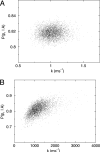Direct Determination of Kinetic Rates from Single-Molecule Photon Arrival Trajectories Using Hidden Markov Models
- PMID: 19626138
- PMCID: PMC2713777
- DOI: 10.1021/jp035514+
Direct Determination of Kinetic Rates from Single-Molecule Photon Arrival Trajectories Using Hidden Markov Models
Abstract
The measurement of fluorescence from single protein molecules has become an important new tool in the study of dynamic processes, allowing for the direct visualization of the motions experienced by individual proteins and macromolecular complexes. The data from such single-molecule experiments are in the form of photon trajectories, consisting of arrival times and wavelength information on individual photons. The analysis of photon trajectories can be difficult, particularly if the motions are occurring at rates comparable to the photon arrival rate or in the presence of noise. In this paper, we introduce the use of hidden Markov models (HMMs) for the analysis of photon trajectory data that operate using the photon data directly, without the need for ensemble averaging of the data as implied by correlation function analysis. Using a simple kinetic model, we examine the relationship between the uncertainty in the estimates of the motional rate and the photon detection rate. Remarkably, we obtain relative uncertainties in the rate constants of as little as 3% even when the interconversion rate is equal to the photon detection rate, and the uncertainty increases to only 10% when the interconversion rate is 10 times the photon detection rate. This suggests that useful information can be obtained for much faster kinetic regimes than have typically been studied. We also examine the impact of background photons on the determination of the rate and demonstrate that the HMM-based approach is robust, displaying small uncertainties for background photon arrival rates approaching that of the signal. These results not only are relevant in establishing the theoretical limits on precision, but are also useful in the context of experimental design. Finally, to demonstrate how the methodology can be extended to more complex kinetic models and how it can allow one to make use of the full power of statistics for purposes of model evaluation and selection, we consider a four-state kinetic model for protein conformational transitions previously studied by Schenter et al. (J. Phys. Chem. A1999, 103, 10477). We show how an HMM can be used as an alternative to higher-order correlation function analysis for the detection of "conformational memory" and apparent non-Markovian dynamics arising from such temporally inhomogeneous kinetic schemes.
Figures






References
-
- Moerner WE. J. Phys. Chem. B. 2002;106:910–927.
-
- Rigler R, Edman L, Foldes-Papp Z, Wennmalm S. Springer Ser. Chem. Phys. 2001;67:177–194.
-
- Xie XS, Lu HP. Springer Ser. Chem. Phys. 2001;67:227–240.
-
- Weiss S. Nat. Struct. Biol. 2000;7:724–729. - PubMed
Grants and funding
LinkOut - more resources
Full Text Sources
Other Literature Sources
